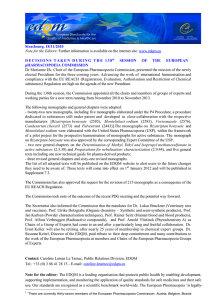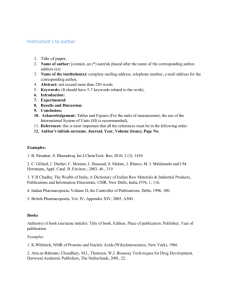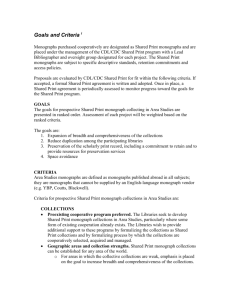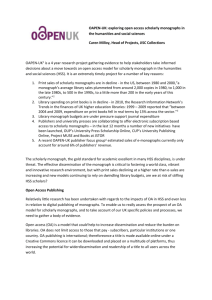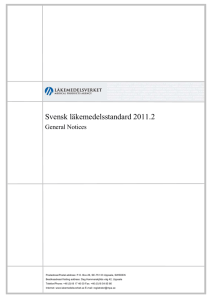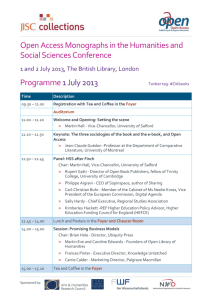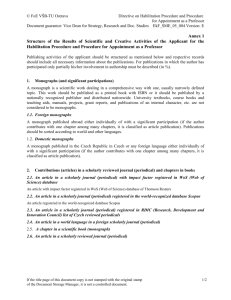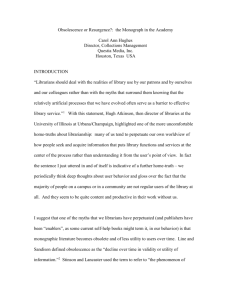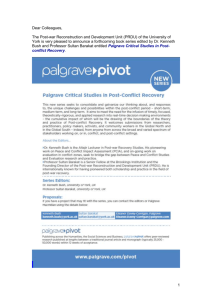ii. introduction
advertisement
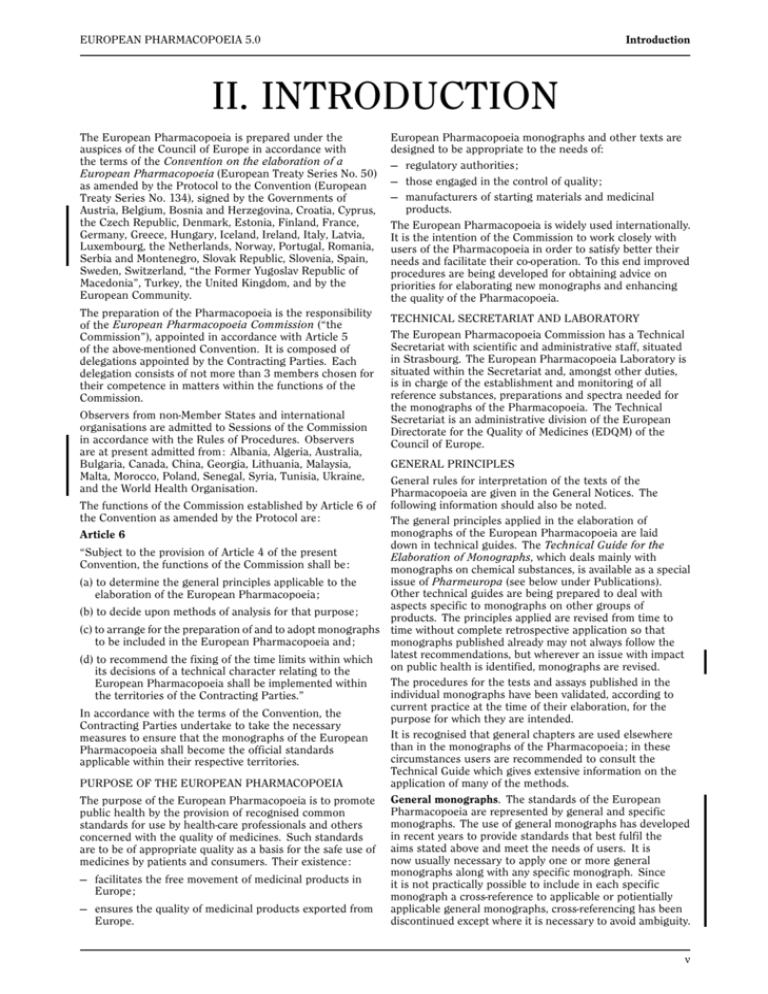
Introduction EUROPEAN PHARMACOPOEIA 5.0 II. INTRODUCTION The European Pharmacopoeia is prepared under the auspices of the Council of Europe in accordance with the terms of the Convention on the elaboration of a European Pharmacopoeia (European Treaty Series No. 50) as amended by the Protocol to the Convention (European Treaty Series No. 134), signed by the Governments of Austria, Belgium, Bosnia and Herzegovina, Croatia, Cyprus, the Czech Republic, Denmark, Estonia, Finland, France, Germany, Greece, Hungary, Iceland, Ireland, Italy, Latvia, Luxembourg, the Netherlands, Norway, Portugal, Romania, Serbia and Montenegro, Slovak Republic, Slovenia, Spain, Sweden, Switzerland, “the Former Yugoslav Republic of Macedonia”, Turkey, the United Kingdom, and by the European Community. European Pharmacopoeia monographs and other texts are designed to be appropriate to the needs of: — regulatory authorities ; — those engaged in the control of quality ; — manufacturers of starting materials and medicinal products. The European Pharmacopoeia is widely used internationally. It is the intention of the Commission to work closely with users of the Pharmacopoeia in order to satisfy better their needs and facilitate their co-operation. To this end improved procedures are being developed for obtaining advice on priorities for elaborating new monographs and enhancing the quality of the Pharmacopoeia. The preparation of the Pharmacopoeia is the responsibility of the European Pharmacopoeia Commission (“the Commission”), appointed in accordance with Article 5 of the above-mentioned Convention. It is composed of delegations appointed by the Contracting Parties. Each delegation consists of not more than 3 members chosen for their competence in matters within the functions of the Commission. TECHNICAL SECRETARIAT AND LABORATORY The European Pharmacopoeia Commission has a Technical Secretariat with scientific and administrative staff, situated in Strasbourg. The European Pharmacopoeia Laboratory is situated within the Secretariat and, amongst other duties, is in charge of the establishment and monitoring of all reference substances, preparations and spectra needed for the monographs of the Pharmacopoeia. The Technical Secretariat is an administrative division of the European Directorate for the Quality of Medicines (EDQM) of the Council of Europe. Observers from non-Member States and international organisations are admitted to Sessions of the Commission in accordance with the Rules of Procedures. Observers are at present admitted from : Albania, Algeria, Australia, Bulgaria, Canada, China, Georgia, Lithuania, Malaysia, Malta, Morocco, Poland, Senegal, Syria, Tunisia, Ukraine, and the World Health Organisation. GENERAL PRINCIPLES General rules for interpretation of the texts of the Pharmacopoeia are given in the General Notices. The The functions of the Commission established by Article 6 of following information should also be noted. the Convention as amended by the Protocol are : The general principles applied in the elaboration of monographs of the European Pharmacopoeia are laid Article 6 down in technical guides. The Technical Guide for the “Subject to the provision of Article 4 of the present Elaboration of Monographs, which deals mainly with Convention, the functions of the Commission shall be : monographs on chemical substances, is available as a special issue of Pharmeuropa (see below under Publications). (a) to determine the general principles applicable to the Other technical guides are being prepared to deal with elaboration of the European Pharmacopoeia ; aspects specific to monographs on other groups of (b) to decide upon methods of analysis for that purpose ; products. The principles applied are revised from time to (c) to arrange for the preparation of and to adopt monographs time without complete retrospective application so that to be included in the European Pharmacopoeia and ; monographs published already may not always follow the (d) to recommend the fixing of the time limits within which latest recommendations, but wherever an issue with impact on public health is identified, monographs are revised. its decisions of a technical character relating to the The procedures for the tests and assays published in the European Pharmacopoeia shall be implemented within individual monographs have been validated, according to the territories of the Contracting Parties.” current practice at the time of their elaboration, for the In accordance with the terms of the Convention, the purpose for which they are intended. Contracting Parties undertake to take the necessary It is recognised that general chapters are used elsewhere measures to ensure that the monographs of the European than in the monographs of the Pharmacopoeia ; in these Pharmacopoeia shall become the official standards circumstances users are recommended to consult the applicable within their respective territories. Technical Guide which gives extensive information on the PURPOSE OF THE EUROPEAN PHARMACOPOEIA application of many of the methods. The purpose of the European Pharmacopoeia is to promote General monographs. The standards of the European Pharmacopoeia are represented by general and specific public health by the provision of recognised common monographs. The use of general monographs has developed standards for use by health-care professionals and others in recent years to provide standards that best fulfil the concerned with the quality of medicines. Such standards are to be of appropriate quality as a basis for the safe use of aims stated above and meet the needs of users. It is now usually necessary to apply one or more general medicines by patients and consumers. Their existence : monographs along with any specific monograph. Since — facilitates the free movement of medicinal products in it is not practically possible to include in each specific Europe ; monograph a cross-reference to applicable or potientially — ensures the quality of medicinal products exported from applicable general monographs, cross-referencing has been Europe. discontinued except where it is necessary to avoid ambiguity. v Introduction A list of general monographs is included in each new edition and supplement to aid users in identifying those that are needed for use with a specific monograph. Use of animals. In accordance with the European Convention on the protection of animals used for experimental and other scientific purposes (1986), the Commission is committed to the reduction of animal usage, wherever possible, in pharmacopoeia testing and encourages those associated with its work to seek alternative procedures. An alternative or modified method is adopted by the Commission once it has been clearly demonstrated that it offers satisfactory control for pharmacopoeial purposes. Considerable progress was made in this area while the 4th Edition was in force and while the 5th Edition was being prepared. Hydrates. With the publication of the 4th Edition, the policy on monograph titles for hydrated forms was changed. For all monographs published for the first time in the 4th Edition or subsequent editions, the degree of hydration, where applicable, is indicated in the monograph title. In previous editions, the policy was to indicate the degree of hydration only where several forms exist. If a monograph on both an anhydrous and a hydrated form of a given substance are published, then “anhydrous” will be included in the title of the relevant form. In order to avoid placing an unnecessary burden on manufacturers for relabelling, this policy will not be applied retrospectively to monographs published already, unless there is reason to believe that this is justified as a public health measure, notably for safety reasons where the substance contains a large proportion of water. Chiral substances. Monographs on chiral substances that describe a particular enantiomer have a test to confirm enantiomeric purity, usually by measurement of optical rotation. Monographs that describe racemates are, in this respect, heterogeneous because of changes of policy during the 3rd Edition. Older monographs do not always have a test to show racemic character. During the course of the 3rd Edition, a test for racemic character was included in all new and revised monographs on racemates, using measurement of optical rotation. When it was shown that in many cases a test for optical rotation, even with narrow limits around zero rotation, was not necessarily sufficiently discriminating because of the low specific optical rotation of the enantiomers, the Commission modified the policy applied. A test for racemic character using optical rotation is now included only if there is information on the specific optical rotation of the enantiomers that indicates that such a test would be discriminating in terms of enantiomeric purity. If other techniques, such as circular dichroism, can serve the intended purpose, they will be prescribed instead of optical rotation. Polymorphism. Where a substance shows polymorphism, this is usually stated under Characters. In general, no particular crystalline form is required in monographs ; exceptionally, in a few monographs, the crystalline form required is specified, for example, via an infrared absorption spectrophotometric identification test where the spectrum is required to be recorded using the substance in the solid state without recrystallisation, the chemical reference substance provided being of the required crystalline form. However, for substances other than these exceptional cases, depending on the use of a given substance in a dosage form, it may be necessary for a manufacturer to ensure that a particular crystalline form is used. The information given under Characters is intended to alert users to the need to evaluate this aspect during the development of a dosage form. The monograph on Substances for pharmaceutical use (2034) and 5.9. Polymorphism should also be consulted. vi EUROPEAN PHARMACOPOEIA 5.0 Specificity of assays. For the elaboration of monographs on chemical substances, the approach generally preferred by the Commission is to provide control of impurities via a well designed Tests section rather than by the inclusion of an assay that is specific for the active moiety. It is therefore the full set of requirements of a monograph that is designed to ensure that the product is of suitable quality. Impurities. Following a review of policy on control of impurities, a new general chapter 5.10. Control of impurities in substances for pharmaceutical use has been included in the 5th Edition. Together with the general monograph Substances for pharmaceutical use (2034), it describes the policy of controlling impurities in specific monographs and provides explanations on how the limits in the related substances test should be understood. Currently the test is a limit test (comparison of peaks areas). In the future (next Edition) and in order to be in line with licensing practice and international collaboration, this test will progressively be changed to utilise a quantitative acceptance criterion. At present, some of the current monographs already satisfy this approach. Except where required for the application of the monograph, in which case the name is followed by “CRS”, impurities are not provided as reference substances nor can they be provided for experimental purposes. Chromatographic columns. As an aid to users, information is made available via the web site www.pheur.org on chromatographic columns that have been found satisfactory during development of monographs and general methods. Information is also given on other equipment and reagents where this is considered useful. This information is given without warranty and does not imply that other columns, equipment or reagents than those specified are not suitable. Residual solvents. The requirements for residual solvents are given in the monograph Substances for pharmaceutical use (2034) together with the general chapters 2.4.24. Identification and control of residual solvents and 5.4. Residual solvents. Thus all active substances and excipients are subject to relevant control of residual solvents, even where no test is specified in the individual monograph. The requirements have been aligned with the ICH guideline on this topic. Reference substances, reference preparations and reference spectra. Where necessary for application of a monograph, reference substances, reference preparations and reference spectra are established and provided to users. They are chosen for their suitability for the purposes stated in the monograph and are not necessarily suitable for other uses. Any necessary information for proper use is given, for example a declared content, but no complete certificate of analysis is provided since this is not relevant for the intended use. No expiry date is attributed to reference substances and preparations, which are subjected to regular periodic monitoring to ensure their continued suitability. Where an assigned value for a given attribute, for example chemical content, is provided, no uncertainty for the assigned value is indicated. The reference substances, preparations and spectra are provided to enable the analyst to determine compliance or otherwise with a monograph. The uncertainty of an assigned value is not to be taken into account when judging compliance, since the uncertainty is already allowed for in the prescribed limits. Medical devices. All editions of the Pharmacopoeia have contained monographs on articles that are regarded as medical devices. For Member States of the European Union, a unified framework for standardisation of medical devices is now provided by a Directive (93/42/EEC). Following EUROPEAN PHARMACOPOEIA 5.0 an agreement between the various parties involved, the Commission has decided that the monographs on medical devices will be deleted once standards have been developed as foreseen by the Directive. Specifications included in the section on containers will be adapted to take account of future standards developed within the framework of the Directive. The monographs on surgical sutures remain in the Pharmacopoeia but they have been modified to conform to the requirements of the Directive and are now to be seen as standards of the type foreseen there. This adaptation of the monographs has involved deletion of some monographs on specific types of sutures in favour of a more general approach. Homoeopathic preparations. A general monograph on homoeopathic preparations was added to the Pharmacopoeia during the 2nd Edition. A number of monographs on substances used in homoeopathic preparations are now also included and further monographs are in preparation. All of these texts have been grouped in a separate section. It is understood that when the same substance is used in both homoeopathic and other preparations then the monograph in the main body of the Pharmacopoeia applies. Patents. The description in the Pharmacopoeia of articles subject to protection by patent does not confer or imply any right to the use of such patents by any person or persons other than the proprietors of the patents concerned. Protected species. Monographs, notably those on herbal drugs, may cover material obtained from protected species. Inclusion of these monographs is without prejudice to the provisions for protection of these species by national and international law. CERTIFICATION PROCEDURE A procedure for the certification of suitability of monographs of the Pharmacopoeia with respect to control of the purity of a product from a given source has been established [see Public Health Committee (Partial Agreement) Resolution AP-CSP (99) 4 or any subsequent revision available from EDQM and on the web site (www.pheur.org)] as an aid to the use of monographs in applications for marketing authorisation. The certification procedure also applies to herbal drugs, herbal drug preparations and transmissible spongiform encephalopathy (TSE) risk. Certificates may be granted with respect to published monographs. Details of the operation of this scheme are Introduction available from the Secretariat and on the EDQM web site. A daily updated list of certificates granted is available on-line on the EDQM web site. A list of voided or suspended certificates is also published in Pharmeuropa. PUBLICATIONS The European Pharmacopoeia is available in English and French versions in the form of a book with 3 supplements per year, and in electronic form (internet and CD-ROM). Pharmeuropa, the European Pharmacopoeia Forum, is published 4 times per year as an aid in the elaboration of monographs and as a vehicle for information on pharmacopoeial and related matters. It is available on subscription from EDQM. Web site. Information on activities and many other aspects of the European Pharmacopoeia is to be found on the EDQM web site (www.pheur.org). Implementation. The date on which monographs are to be implemented is fixed by a resolution of the Public Health Committee (Partial Agreement) of the Council of Europe, following a recommendation by the Commission. This date is usually about 6 months after publication. Where a monograph is to be implemented at a date earlier than the next publication date of the Pharmacopoeia or a supplement, a Resolution of the Public Health Committee gives the full text to be implemented. The text is also published in Pharmeuropa for information and posted on the web site as part of the Resolution. Revision programme. Monographs and other texts of the Pharmacopoeia are revised as necessary following a decision of the Commission. Revision proposals are published in Pharmeuropa. INTERNATIONAL HARMONISATION The European Pharmacopoeia is engaged in a process of harmonisation with the Japanese Pharmacopoeia and the United States Pharmacopeia, within an informal structure referred to as the Pharmacopoeial Discussion Group (PDG). The activities are developed in co-ordination with those of the International Conference on Harmonisation (ICH). Information on the status of harmonised texts is given in chapter 5.8. Pharmacopoeial harmonisation. Harmonised general chapters have a preliminary statement indicating interchangeability with the other two pharmacopoeias. vii
